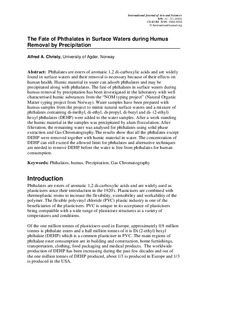The Fate of Phthalates in Surface Waters During Humus Removal by Precipitation
Journal article, Peer reviewed
Permanent lenke
http://hdl.handle.net/11250/138244Utgivelsesdato
2010Metadata
Vis full innførselSamlinger
Originalversjon
Christy, A. A. (2010). The Fate of Phthalates in Surface Waters During Humus Removal by Precipitation. International Journal of Arts and Sciences, 3(9), 11-22.Sammendrag
Phthalates are esters of aromatic 1,2 di-carboxylic acids and are widely found in surface waters and their removal is necessary because of their effects on human health. Humic material in water can adsorb phthalates and may be precipitated along with phthalates. The fate of phthalates in surface waters during humus removal by precipitation has been investigated in the laboratory with well characterised humic substances from the ?NOM typing project? (Natural Organic Matter typing project from Norway). Water samples have been prepared with humus samples from the project to mimic natural surface waters and a mixture of phthalates containing di-methyl, di-ethyl, di-propyl, di-butyl and di- (2-ethyl) hexyl phthalates (DEHP) were added to the water samples. After a week standing the humic material in the samples was precipitated by alum flocculation. After filteration, the remaining water was analysed for phthalates using solid phase extraction and Gas Chromatography.The results show that all the phthalates except DEHP were removed together with humic material in water. The concentration of DEHP can still exceed the allowed limit for phthalates and alternative techniques are needed to remove DEHP before the water is free from phthalates for human consumption.
Beskrivelse
Published version of an article from the journal:International Journal of Arts and Sciences. Also available from the publisher:http://www.openaccesslibrary.org/images/XEW117_Alfred_A._Christy_I_.pdf. Open Access
